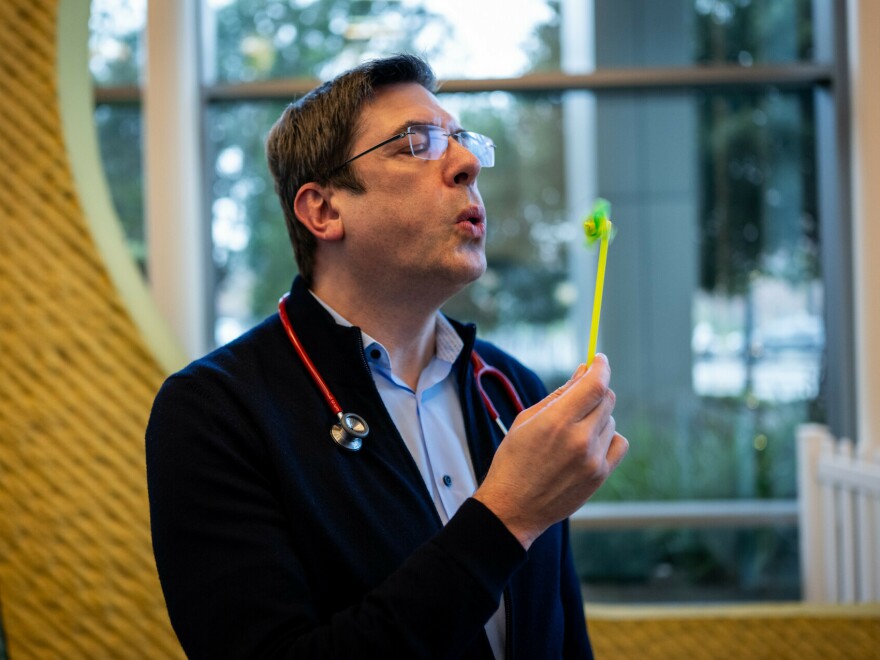Almost all new parents go through it: the distress of hearing their child scream at the doctor's office and the emotional torture of having to hold them down as the clinician sticks them with one vaccine after another.
"The first shots he got, I probably cried more than he did," says Remy Anthes, while pushing her 6-month-old son, Dorian, back and forth in his stroller in Oakland, California.
"The look in her eyes, it's hard to take," says Jill Lovitt, recalling how her infant daughter, Jenna, reacted to some recent vaccines. "Like, 'What are you letting them do to me? Why?'"
Some kids remember the needle pain and quickly start to internalize the fear. That's what Julia Cramer described with her 3-year-old daughter, Maya. Maya had to get some blood drawn for an allergy test when she was 2 1/2.
"After that, she had a fear of blue gloves," Cramer says. "I went to the grocery store and she saw someone wearing blue gloves, stocking the vegetables, and she started freaking out and crying."
Pain management research suggests that needle pokes may be children's biggest source of pain in the health care system.
The problem isn't confined to childhood vaccinations either. Studies looking at sources of pediatric pain have included kids who are being treated for serious illness, who have undergone heart surgeries or bone marrow transplants, or who have landed in the emergency department.
"This is so bad that many children and many parents decide not to continue the treatment," says Dr. Stefan Friedrichsdorf, a specialist at the University of California San Francisco's Stad Center for Pediatric Pain, Palliative and Integrative Medicine, speaking at the End Well conference in Los Angeles last November.
The distress of needle pain can follow kids as they grow and can interfere with important preventive care: An estimated 25% of adults have a fear of needles that began in childhood.
Sixteen percent of adults refuse flu vaccinations because of it.
It doesn't have to be this bad, according to Friedrichsdorf. "This is not rocket science," he says.
He outlines a series of simple steps that clinicians and parents can follow:
- Apply numbing cream, an over-the-counter lidocaine, 30 minutes before a shot.
- Breastfeed babies or give them a pacifier dipped in sugar water, to comfort them while getting a shot.
- Use distractions, like teddy bears, pinwheels or bubbles, to divert attention away from the needle.
- No more pinning kids down on an exam table. Parents should hold children in their laps instead.
Friedrichsdorf worked on a similar effort when he practiced at Children's Minnesota. Now he's leading the rollout of these new protocols for all children at UCSF Benioff Children's Hospitals in San Francisco and Oakland.
He's calling it the "Ouchless Jab Challenge."

If a child at UCSF needs to get poked — for a blood draw, a vaccine or an IV treatment — Friedrichsdorf promises that their clinicians will do everything possible to follow these pain management steps.
"Every child, every time," he says.
It seems unlikely that the ouchless effort would make a dent in vaccine hesitancy and refusal driven by the anti-vaccine movement, since the beliefs that drive it are often conspiracy oriented and deeply held.
But that isn't necessarily Friedrichsdorf's goal.
He hopes that making routine health care less painful for kids could help sway some parents who may be hesitant to get their kids vaccinated because of how hard it is to see them in pain.
In turn, kids who grow into adults without needle phobia might be more likely to get preventive care, including their yearly flu shot.
In general, the onus will likely be on parents to take a leading role in demanding these measures at their own local medical centers, Friedrichsdorf says, because the tolerance and acceptance of children's pain is so entrenched among clinicians.
Dr. Diane Meier, a palliative care specialist at Mount Sinai, agrees. She thinks this tolerance is a major problem, stemming from how doctors are usually trained.
"We are taught to see pain as an unfortunate but inevitable side effect of good treatment," Meier says.
"We learn to repress that feeling of distress at the pain we are causing, because otherwise we can't do our jobs."
During her medical training, Meier had to hold kids down for procedures, which she described as torture — for them and for her. It drove her out of pediatrics.
She went into geriatrics instead and later helped lead the modern movement to promote palliative care in medicine, which became an accredited specialty in the U.S. only in 2006.
Meier thinks the campaign to reduce needle pain and anxiety should be applied to everyone, not just to kids.
"People with dementia have no idea why human beings are approaching them to stick needles in them," she says. And the experience can be painful and distressing.
Friedrichsdorf's techniques would likely work in this population too, she says. Numbing cream, distraction, something sweet in the mouth and perhaps music from the patient's youth that they remember and can sing along to.
"It's worthy of study, and it's worthy of serious attention," Meier says.
This story comes from NPR's health reporting partnership with KQED and KFF Health News.
Copyright 2024 KQED



